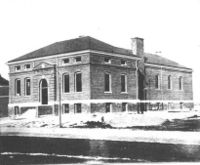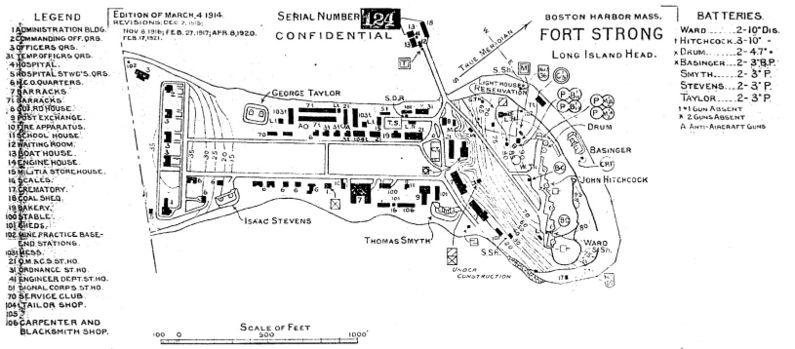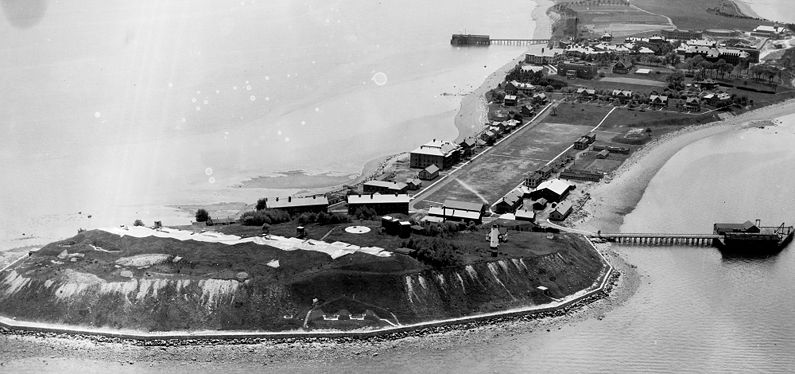Fort Strong (2): Difference between revisions
John Stanton (talk | contribs) No edit summary |
John Stanton (talk | contribs) No edit summary |
||
| (22 intermediate revisions by 2 users not shown) | |||
| Line 1: | Line 1: | ||
{{SocialNetworks}} | {{SocialNetworks}} | ||
{{PageHeader}} | |||
'''{{PAGENAME}}''' (1899-1961) - An [[Endicott Period]] Coastal Fort first established in 1899 on the site of the Battery at Long Island Head on Long Island, Suffolk County, Massachusetts. Named Fort Strong in G.O. 134, 22 Jul 1899, after Major General [[George C. Strong]], U.S. Volunteers, [[U.S. Civil War]]. Abandoned in 1961. | '''{{PAGENAME}}''' (1899-1961) - An [[Endicott Period]] Coastal Fort first established in 1899 on the site of the Battery at Long Island Head on Long Island, Suffolk County, Massachusetts. Named Fort Strong in G.O. 134, 22 Jul 1899, after Major General [[George C. Strong]], U.S. Volunteers, [[U.S. Civil War]]. Abandoned in 1961. | ||
{|width="795px" cellpadding="5px" | {|width="795px" cellpadding="5px" | ||
|- valign="top" | |- valign="top" | ||
|width="50%"|[[Image:.jpg|300px|thumb|left| | |width="50%"|[[Image:Fort Strong2 1905 Barracks Bldg 11.jpg|300px|thumb|left|Fort Strong, 1905 Barracks Bldg. 11 Destroyed by Fire 10 Nov 1933]] | ||
|width="50%"|[[Image:.jpg| | |width="50%"|[[Image:Fort Strong2 1907 NCO Duplex Qtrs.jpg|325px|thumb|right|Fort Strong, 1907 NCO Duplex Quarters]] | ||
|- | |- | ||
|colspan="2"|[[Image:.jpg|795px|thumb|center| | |colspan="2"|[[Image:Fort Strong2 1911 Double Barracks.jpg|795px|thumb|center|Fort Strong 1911 Double Barracks]] | ||
|} | |} | ||
== [[Endicott Period]] (1890-1910) == | == [[Endicott Period]] (1890-1910) == | ||
{{HDBoston}} | {{HDBoston}} | ||
[[Image:Fort Strong2 1907 PX-Gym.jpg|thumb|left|200px|Fort Strong, 1907 PX-Gym]] | |||
Seven [[Endicott Period]] gun batteries and a mine casemate were constructed on Fort Strong (2) between 1893 and 1906. | Seven [[Endicott Period]] gun batteries and a mine casemate were constructed on Fort Strong (2) between 1893 and 1906. | ||
The post was built out as a two company, open plan, coastal fort between 1901 and 1907. The post buildings surrounded a rectangular parade with the officer quarters on the south end. The NCO quarters lined the east side and the two enlisted barracks angled off from the northeast corner. In 1911 the post was expanded to a four company post and a new double barracks (218 men) was constructed on the east side of the parade. Additional officer and NCO quarters were built accordingly. By the end of 1911 the post was virtually complete except for a bakery that was added in 1915. | |||
{{Clr}} | {{Clr}} | ||
{{FtStrong2EndicottPeriod}} | {{FtStrong2EndicottPeriod}} | ||
[[Image:Fort Strong Plan 1921.jpg|thumb|left|795px|Fort Strong 1921 Plan]] | [[Image:Fort Strong Plan 1921.jpg|thumb|left|795px|Fort Strong 1921 Plan]] | ||
[[Image:Fort Strong Aerial View.jpg|thumb|left|795px|Fort Strong Aerial View]] | |||
{{Clr}} | {{Clr}} | ||
== [[World War I]] (1917-1918) == | == [[World War I]] (1917-1918) == | ||
Fort strong expanded during [[World War I]] with the addition of several WWI temporary buildings which can still be seen on the 1921 post plan. Two temporary long barracks and a mess hall can be seen on the west side of the parade. By 1938 all of those temporary buildings are gone as is one of the permanent single company barracks. That barracks, building #11, was destroyed by fire on 10 Nov 1933 and not rebuilt. | |||
Designated a sub-post of [[Fort Banks (1)]] after the end of the war. | Designated a sub-post of [[Fort Banks (1)]] after the end of the war. | ||
A two-gun AA Battery #3 was built in 1917 and expanded to three guns in 1935. [[Battery Drum]] was deactivated in 1917 and had its guns and carriages shipped elsewhere. [[Battery Smyth]] was deactivated in 1921 and its guns were relocated to [[Battery Basinger]]. Both [[Battery Hitchcock]] and [[Battery Ward]] were deactivated in 1938. | |||
{{Clr}} | |||
== [[World War II]] (1941-1945) == | == [[World War II]] (1941-1945) == | ||
The post again expanded with temporary buildings during [[World War II]]. Three 63 man barracks, a mess hall and various support buildings brought the post capacity up to 48 officers, 7 NCOs and 516 enlisted men. Only [[Battery Stevens]] and [[Battery Basinger]] remained operational throughout [[World War II]] and no new gun batteries were constructed on Fort Strong during the war. | |||
After the war, the post was declared surplus on 30 Sep 1947. | |||
== [[Cold War]] (1947-1991)== | == [[Cold War]] (1947-1991)== | ||
Fort Strong housed NIKE missile launch site B-35R in the 1950s, with the control site in Squantum and the Radar Section, 15th AAA Group (1958-1961). A target tracking radar was built in Battery Drum and only the footings remain. | Fort Strong housed NIKE missile launch site B-35R in the 1950s, with the control site in Squantum and the Radar Section, 15th AAA Group (1958-1961). A target tracking radar was built in [[Battery Drum]] and only the footings remain. | ||
{{FortStrong2Cmdrs}} | |||
== Current Status == | == Current Status == | ||
Closed to the public, obtain permission in advance of visit. Operated by The Boston Public Health Commission on Long Island, Suffolk County, Massachusetts. | Closed to the public, obtain permission in advance of visit. Operated by The Boston Public Health Commission on Long Island, Suffolk County, Massachusetts. | ||
{| | {| | ||
| | | | ||
<googlemap version="0.9" lat="42. | <googlemap version="0.9" lat="42.32887" lon="-70.957582" zoom="16" width="-500" height="-500" scale="yes" overview="yes" controls="large" icons="http://www.fortwiki.com/mapicons/icon{label}.png"> | ||
(F) 42. | (F) 42.327934, -70.958848 | ||
Fort Strong (2)<br>(1899-1961) | Fort Strong (2)<br>(1899-1961) | ||
(B) 42.327048, -70.960814 | |||
[[Battery Taylor (1)]] | |||
(B) 42.330788, -70.956376 | |||
[[Battery Basinger]] | |||
(B) 42.329683, -70.955157 | |||
[[Battery Ward]] | |||
(B) 42.32997, -70.955928 | |||
[[Battery Hitchcock]] | |||
(B) 42.3303, -70.956473 | |||
[[Battery Drum]] | |||
(B) 42.328549, -70.956866 | |||
[[Battery Smyth]] | |||
(B) 42.325903, -70.959776 | |||
[[Battery Stevens]] | |||
</googlemap> | </googlemap> | ||
|valign="top"| | |valign="top"| | ||
| Line 46: | Line 74: | ||
* {{Roberts}}, page 411 | * {{Roberts}}, page 411 | ||
{{HBSuppBostonWWII}} | {{HBSuppBostonWWII}} | ||
'''Links:''' | '''Links:''' | ||
| Line 53: | Line 80: | ||
* [http://en.wikipedia.org/wiki/Long_Island_(Massachusetts) Wikipedia - Long Island] | * [http://en.wikipedia.org/wiki/Long_Island_(Massachusetts) Wikipedia - Long Island] | ||
* [http://www.cityofboston.gov/environment/harborislands/history.asp City of Boston - Harbor Islands] | * [http://www.cityofboston.gov/environment/harborislands/history.asp City of Boston - Harbor Islands] | ||
* {{CDSGMainLink}} | |||
{{Visited|No}} | {{Visited|No}} | ||
__NOTOC__ | __NOTOC__ | ||
{{PageFooter}} | |||
{{DEFAULTSORT:Strong (2)}} | {{DEFAULTSORT:Strong (2)}} | ||
[[Category:All]] | [[Category:All]] | ||
| Line 70: | Line 93: | ||
[[Category:Harbor Defense of Boston]] | [[Category:Harbor Defense of Boston]] | ||
[[Category:{{PAGENAME}}]] | [[Category:{{PAGENAME}}]] | ||
[[Category:Endicott Period Forts]] | [[Category:Endicott Period Forts]] | ||
[[Category:World War I Forts]] | [[Category:World War I Forts]] | ||
[[Category:World War I Coastal Forts]] | |||
[[Category:World War II Forts]] | [[Category:World War II Forts]] | ||
[[Category:World War II Coastal Forts]] | |||
[[Category:Starter Page]] | [[Category:Starter Page]] | ||
[[Category:Massachusetts Not Visited]] | |||
Latest revision as of 14:42, 12 February 2020
|
Fort Strong (2) (1899-1961) - An Endicott Period Coastal Fort first established in 1899 on the site of the Battery at Long Island Head on Long Island, Suffolk County, Massachusetts. Named Fort Strong in G.O. 134, 22 Jul 1899, after Major General George C. Strong, U.S. Volunteers, U.S. Civil War. Abandoned in 1961.
Endicott Period (1890-1910)Part of the Harbor Defense of Boston, Massachusetts.  Seven Endicott Period gun batteries and a mine casemate were constructed on Fort Strong (2) between 1893 and 1906. The post was built out as a two company, open plan, coastal fort between 1901 and 1907. The post buildings surrounded a rectangular parade with the officer quarters on the south end. The NCO quarters lined the east side and the two enlisted barracks angled off from the northeast corner. In 1911 the post was expanded to a four company post and a new double barracks (218 men) was constructed on the east side of the parade. Additional officer and NCO quarters were built accordingly. By the end of 1911 the post was virtually complete except for a bakery that was added in 1915.
 
World War I (1917-1918)Fort strong expanded during World War I with the addition of several WWI temporary buildings which can still be seen on the 1921 post plan. Two temporary long barracks and a mess hall can be seen on the west side of the parade. By 1938 all of those temporary buildings are gone as is one of the permanent single company barracks. That barracks, building #11, was destroyed by fire on 10 Nov 1933 and not rebuilt. Designated a sub-post of Fort Banks (1) after the end of the war. A two-gun AA Battery #3 was built in 1917 and expanded to three guns in 1935. Battery Drum was deactivated in 1917 and had its guns and carriages shipped elsewhere. Battery Smyth was deactivated in 1921 and its guns were relocated to Battery Basinger. Both Battery Hitchcock and Battery Ward were deactivated in 1938.
World War II (1941-1945)The post again expanded with temporary buildings during World War II. Three 63 man barracks, a mess hall and various support buildings brought the post capacity up to 48 officers, 7 NCOs and 516 enlisted men. Only Battery Stevens and Battery Basinger remained operational throughout World War II and no new gun batteries were constructed on Fort Strong during the war. After the war, the post was declared surplus on 30 Sep 1947. Cold War (1947-1991)Fort Strong housed NIKE missile launch site B-35R in the 1950s, with the control site in Squantum and the Radar Section, 15th AAA Group (1958-1961). A target tracking radar was built in Battery Drum and only the footings remain.
Current StatusClosed to the public, obtain permission in advance of visit. Operated by The Boston Public Health Commission on Long Island, Suffolk County, Massachusetts.
Sources:
Links:
Visited: No | |||||||||||||||||||||||||||||||||||||||||||||||||||||||||||||||||||||||||||||||||||||||||||||||||||||||||||||||


